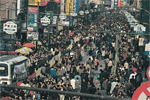
The endangered tomato frog in Madagascar. Photo by Rhett A. Butler.
Projected urban expansion could consume hundreds of thousands of hectares’ worth of key biodiversity hotspots over the next twenty years, triggering the release of some 5 billion tons of carbon dioxide from direct land use change and further endangering hundreds of species, warns a new study published in the journal Proceedings of the National Academy of Sciences.
City populations are expected to grow by five billion people and expand by 1.2 million square kilometers by 2030. Much of this expansion is forecast to occur in the tropics, which contain the bulk of the world’s species. The new study attempts to quantify the impact of urbanization on the world’s so-called “hotspots” — nearly three dozen areas with exceptionally high levels of species found no where else.
Using data from a variety of sources, researchers at Yale University, Texas A&M University, and Boston University developed a probabilistic model for estimating the impacts of urbanization on vegetation, carbon stocks, and threatened species. They found that by 2030, nearly three percent of hotspot areas will be urbanized, up from one percent in 2000. While the extent seems small, paving over marshes, forests, and grasslands could generate 1.38 billion tons of carbon emissions (5 billion tons of CO2) from direct land use change. Some 214 species currently listed as endangered and critically endangered and considered focal species by the Alliance for Zero Extinction (AZE) would be affected by urban expansion, including 20 — 15 of which are amphibians — that would experience complete urbanization of their habitat.
The biggest increase in hotspot urbanization is forecast in Africa and Asia, specifically the Eastern Afromontane, the Guinean Forests of West Africa, the Western Ghats and Sri Lanka hotspots, according to the study. The biggest biodiversity impacts would occur in Africa and Europe.
“Africa and Europe are expected to have the highest percentages of AZE species to be affected by urban expansion, 30% and 33%, respectively,” the authors write. “However, the Americas will have the largest number of species affected by urban expansion, 134, representing one quarter of all AZE species in the region.”


The study however does not capture the full impact of urban expansion on biodiversity or carbon emissions. Urban expansion is being fueled by rural abandonment, which in some places is enabling natural vegetation to regenerate, sequestering carbon and potentially restoring habitat for wildlife. But on the flip side, city-dwellers generally have a larger carbon footprint than poor farmers, consuming more commodities that are often sourced from conversion of lowland habitats, which store more carbon than the upland habitats where natural vegetation is typically regenerating, according to other studies. Therefore the overall impact of urbanization is difficult to estimate, as noted by the authors.
“The analysis in this article only examines the direct spatial ‘imprint’ of urban expansion on biodiversity hotspots, AZE species, and carbon biomass, and not the indirect land-change processes that both drive and respond to urbanization. Urban expansion can also affect land uses in distal places, which in turn can alter carbon stocks, especially in the tropics. This ‘indirect’ urbanization affect is difficult to fully quantify,” they write.
“In some cases, it will amplify and in other cases attenuate carbon losses. We know that cities have always relied on their hinter- lands and other distal places for resources from food and fuel to waste assimilation. For example, a typical household in Sydney or Melbourne is responsible for greenhouse gas emissions, water withdrawals, and land use distributed across all of Australia. The magnitude of the virtual carbon, water, and land embodied in urban areas means that the bulk of environmental impacts from future urban expansion is also likely to occur outside of the areas forecasted to become urban.”
The authors conclude by arguing that while “urbanization is often considered a local issue”, their study shows “shows that the direct impacts of future urban expansion on global biodiversity hotspots and carbon pools are significant.”
“At the same time, the full environmental impacts will not be confined to urban boundaries and will largely be felt elsewhere.”
CITATION: Karen C. Seto, Burak Buneralp, and Lucy R. Hutyra. Global forecasts of urban expansion to 2030 and impacts on biodiversity and carbon pools. PNAS Online Early Edition for the week of September 17-21, 2012.
Related articles
Wealthy consumption threatens species in developing countries

(07/11/2012) Consumption in wealthy nations is imperiling biodiversity abroad, according to a new study in Nature that investigates the link between international trade and biodiversity decline. The study shows how threats to biodiversity and ecosystems, located primarily in developing countries, can be connected to consumer demand for goods in wealthier nations. Some of the major commodities include coffee, cocoa, soy, beef and palm oil.
Fire risk to increase in the Amazon rainforest
(06/20/2012) The risk of fire could increase across large parts of the Amazon rainforest due to increasing incident of drought, expansion of road networks, and rural outmigration, said a scientist speaking at the annual meeting of the Association for Tropical Biology and Conservation (ATBC) in Bonito, Brazil.
It’s not just size that matters: how population affects climate change

(11/11/2010) As the world’s population increases, a surge in the number of older adults and the movement of people from the countryside to crowded cities will significantly affect levels of carbon dioxide emissions by 2050, according to a sweeping study published in the 11 October issue of the Proceedings of the National Academy of Sciences. A significant but attainable slowing of the planet’s growing population could achieve up to 29 percent of the total decrease in emissions needed to stave off the harmful consequences of climate change by 2050, according to the study.
Over 80 percent of urban Congolese eat bushmeat
(06/27/2011) Bushmeat is one of the major threats to wildlife in parts of Africa: large and medium-sized animals are vanishing from regions in a trend dubbed by biologists the ’empty forest syndrome’. A number of popularly consumed species are also threatened with global extinction. A new study in mongabay.com’s open access journal Tropical Conservation Science surveyed 1,050 households in Brazzaville, the capital of Republic of the Congo, regarding their consumption of bushmeat only to find that the practice was practically universal: 88.3 percent of households in Brazzaville consumed bushmeat.
Profit, not poverty, increasingly the cause of deforestation
(06/13/2011) A new report highlights the increasing role commodity production and trade play in driving tropical deforestation.
Good stewards of forests at home outsource deforestation abroad
(11/24/2010) As more nations adopt better laws and policies to save and restore forests at home, they may, in fact, be outsourcing deforestation to other parts of the world, according to a new study in the Proceedings of the National Academy of Sciences (PNAS). Looking at six developing nations where forests are recovering—instead of receding—the study found only one of them did not outsource deforestation to meet local demand for wood-products and food, a process known as ‘leakage’.
Commodity trade and urbanization, rather than rural poverty, drive deforestation

(02/07/2010) Deforestation is increasingly correlated to urban population growth and trade rather than rural poverty, suggesting that measures proposed to reduce deforestation will be ineffective if they fail to address demand for commodities produced on forest lands, argues a new paper published in Nature GeoScience.
Changing drivers of deforestation provide new opportunities for conservation

(12/09/2009) Tropical deforestation claimed roughly 13 million hectares of forest per year during the first half of this decade, about the same rate of loss as the 1990s. But while the overall numbers have remained relatively constant, they mask a transition of great significance: a shift from poverty-driven to industry-driven deforestation and geographic consolidation of where deforestation occurs. These changes have important implications for efforts to protect the world’s remaining tropical forests in that environmental lobby groups now have identifiable targets that may be more responsive to pressure on environmental concerns than tens of millions of impoverished rural farmers. In other words, activists have more leverage than ever to impact corporate behavior as it relates to deforestation.
Corporations become prime driver of deforestation, providing clear target for environmentalists
(08/05/2008) The major drivers of tropical deforestation have changed in recent decades. According to a forthcoming article, deforestation has shifted from poverty-driven subsistence farming to major corporations razing forests for large-scale projects in mining, logging, oil and gas development, and agriculture. While this change makes many scientists and conservationists uneasy, it may allow for more effective action against deforestation. Rhett A. Butler of Mongabay.com, a leading environmental science website focusing on tropical forests, and William F. Laurance of the Smithsonian Tropical Research Institute in Panama believe that the shift to deforestation by large corporations gives environmentalists and concerned governments a clear, identifiable target that may prove more responsive to environmental concerns.
Rural population decline may not slow deforestation

(06/03/2007) A new paper shoots down the theory that increasing urbanization will lead to increasing forest cover in the tropics. Writing in the July issue of the journal Biotropica, Sean Sloan, a researcher from McGill University in Montreal, argues that anticipated declines in rural populations via urbanization will not necessarily result in reforestation–a scenario put forth in a controversial paper published in Biotropica last year by Joseph Wright of the Smithsonian Tropical Research Institute in Panama and Helene Muller-Landau of the University of Minnesota. Wright and Muller-Landau said that deforestation rates will likely slow, then reverse, due to declining rural population density in developing countries.